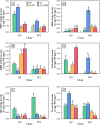Metabolic acclimation supports higher aluminium-induced secretion of citrate and malate in an aluminium-tolerant hybrid clone of Eucalyptus
- PMID: 33407145
- PMCID: PMC7789223
- DOI: 10.1186/s12870-020-02788-4
Metabolic acclimation supports higher aluminium-induced secretion of citrate and malate in an aluminium-tolerant hybrid clone of Eucalyptus
Abstract
Background: Eucalyptus is the main plantation wood species, mostly grown in aluminized acid soils. To understand the response of Eucalyptus clones to aluminum (Al) toxicity, the Al-tolerant Eucalyptus grandis × E. urophylla clone GL-9 (designated "G9") and the Al-sensitive E. urophylla clone GL-4 (designated "W4") were employed to investigate the production and secretion of citrate and malate by roots.
Results: Eucalyptus seedlings in hydroponics were exposed to the presence or absence of 4.4 mM Al at pH 4.0 for 24 h. The protein synthesis inhibitor cycloheximide (CHM) and anion channel blocker phenylglyoxal (PG) were applied to explore possible pathways involved in organic acid secretion. The secretion of malate and citrate was earlier and greater in G9 than in W4, corresponding to less Al accumulation in G9. The concentration of Al in G9 roots peaked after 1 h and decreased afterwards, corresponding with a rapid induction of malate secretion. A time-lag of about 6 h in citrate efflux in G9 was followed by robust secretion to support continuous Al-detoxification. Malate secretion alone may alleviate Al toxicity because the peaks of Al accumulation and malate secretion were simultaneous in W4, which did not secrete appreciable citrate. Enhanced activities of citrate synthase (CS) and phosphoenolpyruvate carboxylase (PEPC), and reduced activities of isocitrate dehydrogenase (IDH), aconitase (ACO) and malic enzyme (ME) were closely associated with the greater secretion of citrate in G9. PG effectively inhibited citrate and malate secretion in both Eucalyptus clones. CHM also inhibited malate and citrate secretion in G9, and citrate secretion in W4, but notably did not affect malate secretion in W4.
Conclusions: G9 immediately secrete malate from roots, which had an initial effect on Al-detoxification, followed by time-delayed citrate secretion. Pre-existing anion channel protein first contributed to malate secretion, while synthesis of carrier protein appeared to be needed for citrate excretion. The changes of organic acid concentrations in response to Al can be achieved by enhanced CS and PEPC activities, but was supported by changes in the activities of other enzymes involved in organic acid metabolism. The above information may help to further explore genes related to Al-tolerance in Eucalyptus.
Keywords: Aluminum tolerance; Citrate; Eucalyptus; Malate; Metabolizing enzymes.
Conflict of interest statement
The authors declare that the research was conducted in the absence of any commercial or financial relationships that could be construed as a potential conflict of interest.
Figures





Similar articles
-
Phosphorus application reduces aluminum toxicity in two Eucalyptus clones by increasing its accumulation in roots and decreasing its content in leaves.PLoS One. 2018 Jan 11;13(1):e0190900. doi: 10.1371/journal.pone.0190900. eCollection 2018. PLoS One. 2018. PMID: 29324770 Free PMC article.
-
Responses of eucalypt species to aluminum: the possible involvement of low molecular weight organic acids in the Al tolerance mechanism.Tree Physiol. 2004 Nov;24(11):1267-77. doi: 10.1093/treephys/24.11.1267. Tree Physiol. 2004. PMID: 15339736
-
Al-induced efflux of organic acid anions is poorly associated with internal organic acid metabolism in triticale roots.J Exp Bot. 2003 Jul;54(388):1753-9. doi: 10.1093/jxb/erg188. Epub 2003 May 28. J Exp Bot. 2003. PMID: 12773523
-
Recent progress in the research of external Al detoxification in higher plants: a minireview.J Inorg Biochem. 2003 Sep 15;97(1):46-51. doi: 10.1016/s0162-0134(03)00245-9. J Inorg Biochem. 2003. PMID: 14507459 Review.
-
Mechanisms and regulation of aluminum-induced secretion of organic acid anions from plant roots.J Zhejiang Univ Sci B. 2019 Jun;20(6):513-527. doi: 10.1631/jzus.B1900188. J Zhejiang Univ Sci B. 2019. PMID: 31090277 Free PMC article. Review.
Cited by
-
Effects of Elevated Aluminum Concentration and Distribution on Root Damage, Cell Wall Polysaccharides, and Nutrient Uptake in Different Tolerant Eucalyptus Clones.Int J Mol Sci. 2022 Nov 3;23(21):13438. doi: 10.3390/ijms232113438. Int J Mol Sci. 2022. PMID: 36362232 Free PMC article.
-
Mycorrhizal symbiosis promotes the nutrient content accumulation and affects the root exudates in maize.BMC Plant Biol. 2022 Feb 5;22(1):64. doi: 10.1186/s12870-021-03370-2. BMC Plant Biol. 2022. PMID: 35123400 Free PMC article.
-
Exogenous silicon induces aluminum tolerance in white clover (Trifolium repens) by reducing aluminum uptake and enhancing organic acid secretion.PeerJ. 2024 May 30;12:e17472. doi: 10.7717/peerj.17472. eCollection 2024. PeerJ. 2024. PMID: 38827280 Free PMC article.
-
Metabolic and Nutritional Responses of Contrasting Aluminium-Tolerant Banana Genotypes Under Al Stress.Plants (Basel). 2025 Jan 27;14(3):385. doi: 10.3390/plants14030385. Plants (Basel). 2025. PMID: 39942947 Free PMC article.
References
-
- Ye SM, Wen YG, Yang M, Liang HW. Correlation analysis on biodiversity and soil physical& chemical properties of Eucalyptus spp. plantations under successive rotation. J Soil Water Conserv. 2010;24:246–251.
-
- Kinraide TB. Identity of the rhizotoxic aluminium species. Plant Soil. 1991;134:167–178. doi: 10.1007/BF00010729. - DOI
Publication types
MeSH terms
Substances
Grants and funding
LinkOut - more resources
Full Text Sources
Other Literature Sources

